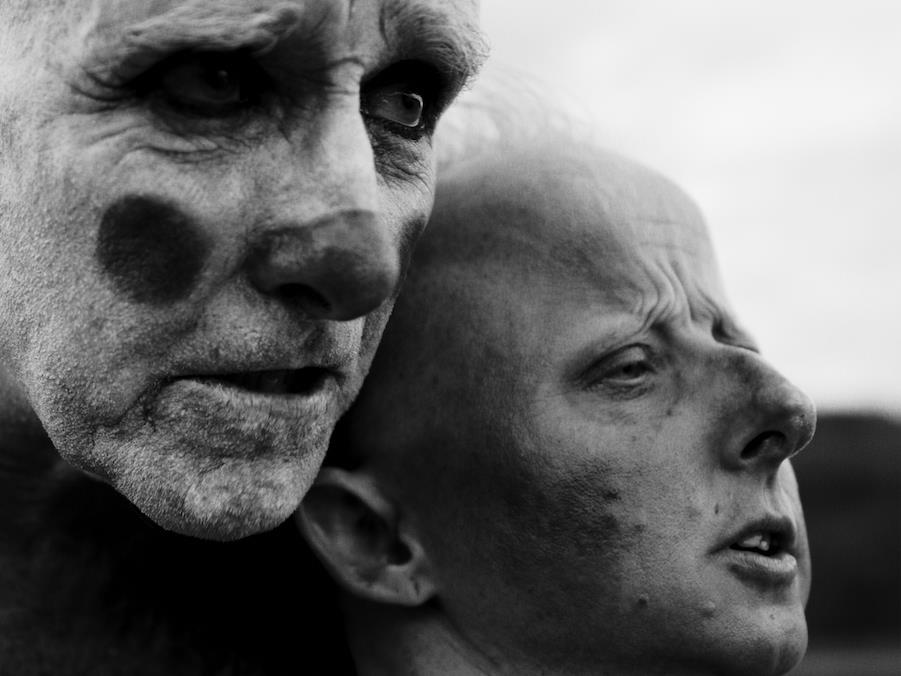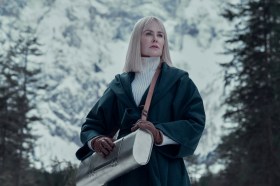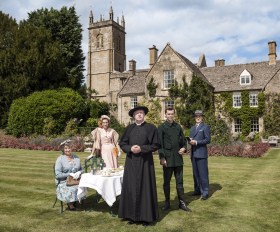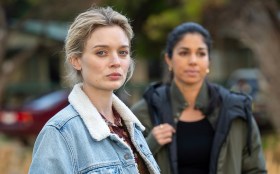Image: Reflections in the Dust. Source: Backlot Films.
When Australian dramas fail to set the box office alight, one reason recurs in the ensuing chatter, with words such as grim, dark and depressing frequently bandied about. Decrying the bleakness of local filmmaking, such commentary proves the flip side to another common criticism levelled at homegrown fare. Where Aussie comedies are concerned, it’s their broad accents, humour and stereotypes that receive similar scrutiny.
There isn’t an ounce of amusement in the second feature from writer/director Luke Sullivan (You’re Not Thinking Straight); however his distinctive sci-fi-tinged drama otherwise hits many of the aforementioned marks. Set in a post-apocalyptic world, primarily shot in black and white, and echoing with clear Australian inflections and phrasing, Reflections in the Dust is both deeply steeped in despair and intrinsically tied to its country of origin. Heavily stylised, and resolutely confronting in its aesthetics and approach, the film’s desolate lens and local flavour are as much the point as its intimate dystopian narrative.
In a swampy corner of a vast wasteland, two figures navigate a new world order that has left them scrambling in isolation. Freckles (Sarah Houbolt) and her father (Robin Royce Queere) occasionally interact with nomadic passersby, but largely endure and survive with no one except each other for company. And yet, their relationship can’t be described as supportive. The young blind woman and schizophrenic clown are forever linked by their harsh circumstances, more so than by blood or love. As Freckles dreams of a different life and the clown frays with fear, anger and paranoia, this truth is revealed — often physically and verbally, via the increasingly brutal treatment directed by the abusive dad towards his daughter.
While Reflections in the Dust is light on detail, preferring to witness its protagonists’ ongoing struggles rather than explain their situation, Sullivan intertwines Freckles and the clown’s plights with to-camera discussions. Dressed in costume, Houbolt and Queere answer questions from an unseen interviewer about love, life, death and hope — furthering their characters’ backstories, but offering their responses with honesty and candour that ranges beyond performance. In contrast to the prevailing monochrome imagery of the film’s dramatic scenes, these clips overflow with brightness, with Houbolt placed against a stark blue background and Queere sat before a wall as red as the clown’s painted nose. The juxtaposition is powerful, and delivered with purpose. Although the daily minutiae of Freckles and the clown’s existence is devoid of colour, their emotions remain vivid and potent.
Violence against women has long become a cinema staple, whether occurring in a domestic environment or at the hands of strangers. On-screen men stalk, slap, strangle, beat, abuse and worse, while on-screen women suffer — and in depicting Freckles’ ordeal with the clown, Reflections in the Dust doesn’t shy away from the resulting horrors. Indeed, Sullivan takes his remit literally. Director of photography Ryan Barry-Cotter rarely moves the camera away from Houbolt and Queere’s expressive faces; when she flinches and exclaims in pain, and when he erupts in a frenzied fury, it’s there for everyone to see. Peering so closely and tightly at its central duo, this tale of anguish deploys its cast as a canvas. And, just as the particulars of their scenario are left are unspoken, much of their world is also left unseen, with the film relegating its hostile landscape to the periphery of its frames.
Here, art both reflects and inverts life. Violence is inescapable, especially for those caught in its cycle, although it’s often pushed aside by the world at large in favour of any other view. Unfurling as an appropriately relentless onslaught by design, Reflections in the Dust doesn’t give its audience any option but to watch (or to walk out, as viewers at its Karlovy Vary world premiere screenings reportedly did). Coupling the feature’s visible woes with Houbolt and Queere’s accents — and with the latter’s constant fondness for one particularly vicious word entrenched in local vernacular — also makes a conscious statement. Reflections in the Dust doesn’t just refuse to look away from Freckles, or from the victimised women that she represents, but from the Australian context that’s baked into its frames.
Sullivan’s approach is bold, ambitious and primed to make an impact; however it’s Houbolt and Queere’s performances that ensures the film hits home. Both actors gift the movie with raw, fearless portrayals, and while Queere’s conflicted clown is much more than a brutish Aussie stereotype, Houbolt remains Reflections in the Dust’s shining star. Drawing upon her circus and theatre background, there’s a sense of immediacy to Freckles’ every look and gesture in Houbolt’s hands. Perhaps grounded in her work as an advocate for disability and diversity, and from her own experience with the rare Hallermann-Streiff syndrome and partial blindness, she also perfects an incredibly specific sensation that couldn’t be more relevant given the feature’s subject matter — of striving to be seen while being all too resigned to the opposite fate.
| 3.5 stars |
★★★☆
|
Reflections in the Dust
Director: Luke Sullivan
Australia, 2018, 74 mins
Australian release date: March 7
Distributor: Backlot Films
Rated: MA
Actors:
Director:
Format:
Country:
Release:





